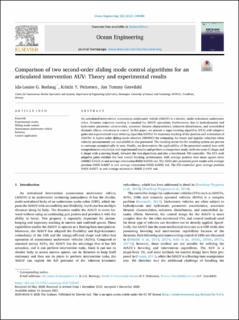| dc.contributor.author | Borlaug, Ida-Louise Garmann | |
| dc.contributor.author | Pettersen, Kristin Ytterstad | |
| dc.contributor.author | Gravdahl, Jan Tommy | |
| dc.date.accessioned | 2021-02-26T07:10:45Z | |
| dc.date.available | 2021-02-26T07:10:45Z | |
| dc.date.created | 2021-01-14T13:01:01Z | |
| dc.date.issued | 2021 | |
| dc.identifier.citation | Ocean Engineering. 2021, 222 108480-?. | en_US |
| dc.identifier.issn | 0029-8018 | |
| dc.identifier.uri | https://hdl.handle.net/11250/2730525 | |
| dc.description.abstract | An articulated intervention autonomous underwater vehicle (AIAUV) is a slender, multi-articulated underwater robot. Accurate trajectory tracking is essential for AIAUV operations. Furthermore, due to hydrodynamic and hydrostatic parameter uncertainties, uncertain thruster characteristics, unknown disturbances, and unmodelled dynamic effects, robustness is crucial. In this paper, we present a super-twisting algorithm (STA) with adaptive gains and a generalized super-twisting algorithm (GSTA) for trajectory tracking of the position and orientation of AIAUVs. A higher-order sliding mode observer (HOSMO) for estimating the linear and angular velocities when velocity measurements are unavailable is also presented. The tracking errors for the resulting system are proven to converge asymptotically to zero. Finally, we demonstrate the applicability of the presented control laws with comprehensive simulation and experimental results and perform a comparison study, with two tests (C-shape and C-shape with a moving head), between the two algorithms and also a benchmark PID controller. The STA with adaptive gains exhibits the best overall tracking performance, with average position root mean square error (RMSE) 0.0121 m and average orientation RMSE 0.0335 rad. The GSTA also presented good results with average position RMSE 0.0267 m and average orientation RMSE 0.0292 rad. The PID controller gave average position RMSE 0.0371 m and average orientation RMSE 0.0491 rad. | en_US |
| dc.language.iso | eng | en_US |
| dc.publisher | Elsevier | en_US |
| dc.rights | Navngivelse 4.0 Internasjonal | * |
| dc.rights.uri | http://creativecommons.org/licenses/by/4.0/deed.no | * |
| dc.title | Comparison of two second-order sliding mode control algorithms for an articulated intervention-AUV: Theory and experimental results | en_US |
| dc.type | Peer reviewed | en_US |
| dc.type | Journal article | en_US |
| dc.description.version | publishedVersion | en_US |
| dc.source.pagenumber | 108480-? | en_US |
| dc.source.volume | 222 | en_US |
| dc.source.journal | Ocean Engineering | en_US |
| dc.identifier.doi | https://doi.org/10.1016/j.oceaneng.2020.108480 | |
| dc.identifier.cristin | 1871323 | |
| dc.relation.project | Norges forskningsråd: 304667 | en_US |
| dc.relation.project | Norges forskningsråd: 223254 | en_US |
| cristin.ispublished | true | |
| cristin.fulltext | postprint | |
| cristin.qualitycode | 1 | |

